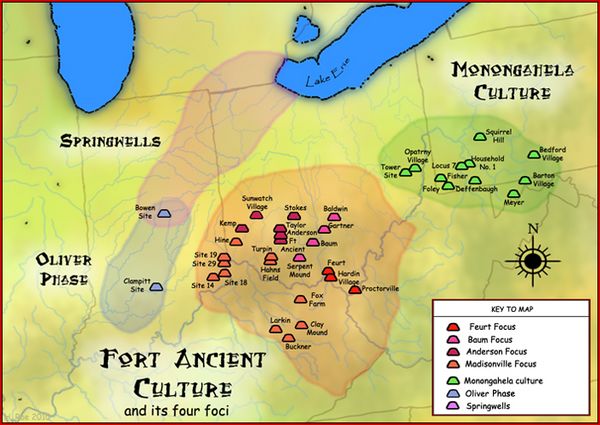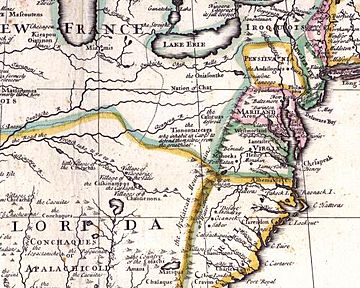Monongahela culture facts for kids
The Monongahela culture was a group of Native American people who lived in what is now western Pennsylvania, western Maryland, eastern Ohio, and West Virginia. They were part of the Iroquoian family. They lived from about AD 1050 to 1635, during a time called the Late Woodland period. The culture was named in 1939 by Mary Butler, after the Monongahela River. Many of their ancient village sites are found in this river valley.
The Monongahela people were farmers, growing crops like maize (corn). They lived in well-planned villages, some of which had 50 to 100 buildings. They traded goods with other Native American groups. These other groups sometimes traded with Europeans. However, the Monongahela people seem to have disappeared around the 1620s or 1630s. This happened before they had much direct contact with Europeans themselves.
Many experts believe that new diseases brought by Europeans caused the Monongahela people to disappear. Others think that most Monongahela people either joined or were defeated by the Iroquois or Algonquian-speaking Lenape tribes. This might have happened during wars over hunting grounds for the fur trade. Some also suggest that two serious droughts, one from 1587 to 1589 and another from 1607 to 1612, made it hard for them to live in the area.
Contents
Life in the Monongahela Culture
The Monongahela culture changed over time. Archaeologists study their pottery to understand these changes.
- Early Monongahela (AD 1050 - 1250): Their pottery often had patterns made by rectangular cuts or horizontal dotted lines.
- Middle Monongahela (AD 1250 - 1580): Pottery surfaces were usually plain. Sometimes, the rim of the pot had simple decorations like notches or marks from a cord-wrapped paddle.
- Late Monongahela (AD 1580 - 1635): Pottery was mostly plain, but decorations appeared on the lips and inside of the rim. During this time, their pottery also showed signs of contact with the Iroquois.
Where They Lived
The Monongahela culture lived in the area around the upper Ohio River system. This includes the Monongahela River, Youghiogheny River, and Casselman River. Their territory covered western Pennsylvania and nearby parts of eastern Ohio, West Virginia, and western Maryland. Nearly 400 ancient sites have been found in this region. They lived at the same time as the Fort Ancient culture, which was in the Ohio Valley.
Monongahela villages first appeared on flat areas near rivers. But by 1250, many people moved to higher lands, often on ridges. Archaeologists believe this move, and the building of larger, protected villages, might have been due to wars between different groups.
One important site is Fort Hill (46MG12) in Morgantown, West Virginia. It's a large archaeological site that seems to have been a Monongahela village. Bones of humans and animals, bone beads, shell beads, pottery, and arrow points have been found there.
Many Monongahela village sites are found near the Pennsylvania and West Virginia border. The Worley village Complex (46Mg23) dates back to about AD 900. Another site, Wana village, was found using infrared photography.
The LaPoe (46Mg21) village complex in Monongalia County, West Virginia was a round village used in the 1500s and 1600s. Items found there show they traded with others. Nearby, there is also a stone burial mound (46Mg18).
What They Made
Pottery
Monongahela pottery was made by coiling clay into shape. They added crushed rock or quartz to the clay to make it stronger. The pottery was usually decorated with marks from cords pressed into the wet clay. Early pottery used grit or limestone to temper the clay. Later, they used different methods.
Women of the Monongahela culture often made pottery with a specific type of cord twist. This twist might have been a unique "signature" for different groups or villages. It helps archaeologists understand how different Monongahela communities were connected.
Village Life
Monongahela houses were small and shaped like ovals or circles. They were built inside villages that had palisades, which are strong fences made of tall wooden posts. These villages usually had a central open area or plaza. The entrances to the villages were often tricky, like a maze, and sometimes covered. Some villages even had raised platforms for watching out.
Larger villages had special buildings called Charnel houses, where bones of the dead might have been kept. Some graves contained black bear masks, which could mean certain people had a special rank. Unlike some other tribes, Monongahela children were sometimes buried inside the village or even under houses. By 1450, many houses had petal-shaped additions. These were used for storage or perhaps as smokehouses.
The Monongahela people made good quality pottery and tools. They also crafted decorated clay pipes for smoking. Even though there are no records of them meeting Europeans directly, some villages have yielded glass trade beads. This suggests they traded with other Native American groups who had contact with Europeans.
Food and Farming
Like the nearby Fort Ancient culture, the Monongahela people were skilled farmers. They learned to grow new crops like maize (corn), beans, squash, and sunflower. They saved seeds from their harvests to plant again the next year. They also gathered wild plants, nuts, and berries to add to their diet. Corn was a very important food for them.
Monongahela men hunted animals like deer and turtles. They also caught fish and shellfish. They grew tobacco and hemp and traded these crops with people living on the East Coast. Evidence of this trade includes seashells from the mid-Atlantic coast found at some Monongahela sites.
Why They Disappeared
The Monongahela culture was at its strongest around AD 1300. Some experts believe that colder weather during the Little Ice Age might have caused groups to fight over food and land. Crops didn't grow as well in the colder climate, leading to food shortages for a growing population. Some studies also suggest that the culture began to decline due to poor health.
As mentioned earlier, two severe droughts (1587-1589 and 1607-1612) might have forced the Monongahela people to leave their homes in search of better places. Also, because they traded with other groups, the Monongahela could have caught infectious diseases from coastal peoples. These coastal groups had direct contact with Europeans. Since Native Americans had no immunity to these new diseases, many people died across wide areas.
The Monongahela culture was already fading when the powerful Iroquois tribes moved into the Allegheny Plateau and Lake Erie regions. The Iroquois wanted to control new hunting grounds for the valuable fur trade. It's likely that the Iroquois either defeated the Monongahela or drove them out.
Around 1635, it seems that some Monongahela people moved to south-central Virginia, in Halifax County. They might have joined a Siouan-speaking tribe in that area, but historians are not completely sure. There were also Algonquian and Iroquoian-speaking tribes nearby.
|




